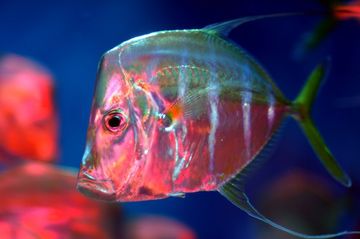The open ocean is a bad place for a game of hide-and-seek —there’s no place to actually hide. For the fish that inhabit the open ocean, though, hide-and-seek is no game — it’s a matter of life and death. Many species have developed ways to camouflage themselves to avoid predators. Some change color, for example, while others are like mirrors — they reflect the view around them.
 And a recent study found one more way in which fish can hide themselves in plain sight: They manipulate the properties of the light that strikes them.
And a recent study found one more way in which fish can hide themselves in plain sight: They manipulate the properties of the light that strikes them.
A team of researchers led by Molly Cummings at the University of Texas studied a fish known as the lookdown. It’s a tall, skinny fish with silvery sides. The researchers placed the fish in tanks, and simulated the daily passage of the Sun across the sky above them. As sunlight enters the water at different angles, its polarity changes.
Polarity is an effect you see when you wear special sunglasses or use a polarizing filter on a camera. The lenses filter out light that scatters about in random directions, allowing only the light waves that are aligned in a certain direction to pass through. Many species of fish can see the change in polarity caused when light reflects off a fish or other solid object.
The researchers found that the lookdown can change the polarity of the light that reflects off its skin to more closely match the polarity in the water around it. In essence, that acts as a cloak — hiding the lookdown from predators that are seeking a meal.

